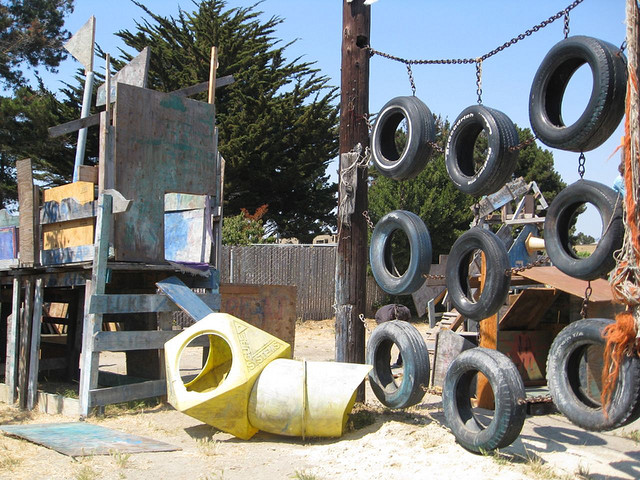
It's National Playground Safety Week, but I'm not celebrating. In fact, I'd like to propose a National Playground Danger Week instead.
Don't get me wrong: I appreciate playground safety. As the CEO of a national nonprofit that has built over 2,000 playgrounds in 15 years, there are certain precautions I'm glad we take. For instance, I'm glad we surface our playgrounds with engineered wood fiber instead of, say, cement. I'm glad that we follow guidelines for swing set placement so that a kid doesn't jump off a swing and sail smack into the side of a building.
That said, we as a country have taken playground safety too far. We have crossed the line from common sense (don't place a swing set next to a building) to that murky "What if?" territory in which we imagine every conceivable accident that could ever take place on a playground (what if a finger gets caught in a see-saw?) and try to guard against it.
The result? Boring, uninspired playgrounds that lack whimsy, risk, and -- yes -- see-saws.
We all have a natural instinct to protect children from harm. It's never fun to see a child hurt, even if it's just a scraped knee. But on the other hand, children need to take on physical challenges to learn and grow, and scraped knees and other bumps and bruises teach them valuable lessons about their own limits.
 When given age-appropriate challenges, children tend to take them very seriously; in fact, the more obvious the risk is, the more cautiously a child will proceed. Adventure Playgrounds are a perfect case in point. While our paranoid and litigious society boasts only a handful, Europe has hundreds, offering kids the opportunity to play with fire, use handsaws and sail across 50-foot zip lines.
When given age-appropriate challenges, children tend to take them very seriously; in fact, the more obvious the risk is, the more cautiously a child will proceed. Adventure Playgrounds are a perfect case in point. While our paranoid and litigious society boasts only a handful, Europe has hundreds, offering kids the opportunity to play with fire, use handsaws and sail across 50-foot zip lines.
Denise Brown, Manager of the Berkeley Adventure Playground in California (pictured right), told NPR in an interview:
What we like to say is that there are no hidden risks in the playground. Even a young child walking through the playground gates can look around and tell that it's a different type of playground, and there are sticks and boards and nails and rocks and things that they need to watch out for.
In her experience, there are fewer injuries on Adventure Playgrounds than at standard U.S. playgrounds. At Kolle 37, an Adventure Playground in Berlin where kids can build their own three-story forts with wood and nails, two children have broken bones and a couple have stepped on nails over the course of five years.
We don't give our kids enough credit. No child wants to fall off a jungle gym or slide. Accidents are an unfortunate fact of life, but to lower every last slide and jungle gym to a height that would only interest a toddler is doing our children a grave disservice. Our instincts to protect and our instincts to immediately point fingers when accidents do happen by filing a lawsuit, are actually hurting our children by denying them the opportunity to take on vital challenges.
During National Playground Safety Week, I'll celebrate common-sense safety. I'll also celebrate skinned knees and bruised elbows. I'll celebrate so-called "dangerous" playgrounds --playgrounds with see-saws, zip lines and towering slides. But I won't laud so-called injury-proof and lawsuit-proof play equipment -- because a boring playground is nothing to celebrate.
- For more on this topic, see my related post: Are Safe Playgrounds Hurting Our Children?
- And for more photos of delightfully dangerous playgrounds, see: Our favorite dangerous playgrounds
Photo by penny (cc).